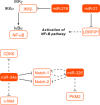MicroRNAs and glioblastoma: roles in core signalling pathways and potential clinical implications
- PMID: 21435175
- PMCID: PMC4373357
- DOI: 10.1111/j.1582-4934.2011.01317.x
MicroRNAs and glioblastoma: roles in core signalling pathways and potential clinical implications
Abstract
MicroRNAs (miRNAs) are endogenously expressed small non-coding RNAs that act as post-transcriptional regulators of gene expression. Dysregulation of these molecules has been indicated in the development of many cancers. Altered expression levels of several miRNAs were identified also in glioblastoma. It was repeatedly found that miRNAs are involved in important signalling pathways, which play roles in crucial cellular processes, such as proliferation, apoptosis, cell cycle regulation, invasion, angiogenesis and stem cell behaviour. Therefore, miRNAs represent promising therapeutic targets in glioblastoma. In this review, we summarize the current knowledge about miRNAs significance in glioblastoma, with special focus on their involvement in core signalling pathways, their roles in drug resistance and potential clinical implications.
© 2011 The Authors Journal compilation © 2011 Foundation for Cellular and Molecular Medicine/Blackwell Publishing Ltd.
Figures



Similar articles
-
Regulation of autophagy by non-coding RNAs in human glioblastoma.Med Oncol. 2024 Oct 7;41(11):260. doi: 10.1007/s12032-024-02513-3. Med Oncol. 2024. PMID: 39375229 Review.
-
Differential expression of MicroRNAs in patients with glioblastoma after concomitant chemoradiotherapy.OMICS. 2013 May;17(5):259-68. doi: 10.1089/omi.2012.0065. Epub 2013 Apr 15. OMICS. 2013. PMID: 23586679
-
Global MicroRNA Expression Profiling Identifies Unique MicroRNA Pattern of Radioresistant Glioblastoma Cells.Anticancer Res. 2017 Mar;37(3):1099-1104. doi: 10.21873/anticanres.11422. Anticancer Res. 2017. PMID: 28314270
-
MicroRNAs involved in the EGFR pathway in glioblastoma.Biomed Pharmacother. 2021 Feb;134:111115. doi: 10.1016/j.biopha.2020.111115. Epub 2020 Dec 16. Biomed Pharmacother. 2021. PMID: 33341046 Review.
-
MicroRNAs as regulators of neural stem cell-related pathways in glioblastoma multiforme.Mol Neurobiol. 2011 Dec;44(3):235-49. doi: 10.1007/s12035-011-8196-y. Epub 2011 Jul 5. Mol Neurobiol. 2011. PMID: 21728042 Review.
Cited by
-
MicroRNA-128 coordinately targets Polycomb Repressor Complexes in glioma stem cells.Neuro Oncol. 2013 Sep;15(9):1212-24. doi: 10.1093/neuonc/not055. Epub 2013 Jun 3. Neuro Oncol. 2013. PMID: 23733246 Free PMC article.
-
miRNA-429 Inhibits Astrocytoma Proliferation and Invasion by Targeting BMI1.Pathol Oncol Res. 2017 Apr;23(2):369-376. doi: 10.1007/s12253-016-0113-2. Epub 2016 Sep 23. Pathol Oncol Res. 2017. PMID: 27663885
-
Exploring the clinical implications and applications of exosomal miRNAs in gliomas: a comprehensive study.Cancer Cell Int. 2024 Sep 27;24(1):323. doi: 10.1186/s12935-024-03507-x. Cancer Cell Int. 2024. PMID: 39334350 Free PMC article. Review.
-
Investigating Pathogenetic Mechanisms of Alzheimer's Disease by Systems Biology Approaches for Drug Discovery.Int J Mol Sci. 2021 Oct 19;22(20):11280. doi: 10.3390/ijms222011280. Int J Mol Sci. 2021. PMID: 34681938 Free PMC article.
-
High-grade glioma in elderly patients: can the oncogeriatrician help?Clin Interv Aging. 2013;8:1617-24. doi: 10.2147/CIA.S35941. Epub 2013 Dec 6. Clin Interv Aging. 2013. PMID: 24353408 Free PMC article. Review.
References
-
- Ohgaki H, Dessen P, Jourde B, et al. Genetic pathways to glioblastoma: a population-based study. Cancer Res. 2005;64:6892–9. - PubMed
-
- Ohgaki H, Kleihues P. Population-based studies on incidence, survival rates, and genetic alterations in astrocytic and oligodendroglial gliomas. J Neuropathol Exp Neurol. 2005;64:479–89. - PubMed
-
- Novakova J, Slaby O, Vyzula R, et al. MicroRNA involvement in glioblastoma pathogenesis. Biochem Biophys Res Commun. 2009;386:1–5. - PubMed
-
- Schwartzbaum JA, Fisher JL, Aldape KD, et al. Epidemiology and molecular pathology of glioma. Nat Clin Pract Neurol. 2006;2:494–503. - PubMed
-
- Ohno M, Natsume A, Kondo Y, et al. The modulation of microRNAs by type I IFN through the activation of signal transducers and activators of transcription 3 in human glioma. Mol Cancer Res. 2009;7:2022–30. - PubMed
Publication types
MeSH terms
Substances
LinkOut - more resources
Full Text Sources

